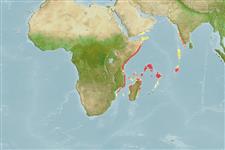>
Aulopiformes (Grinners) >
Paraulopidae (Cucumber fishes)
Etymology: Paraulopus: Paraulopus refers to a taxon related to Aulopus, both being included in the Aulopiformes.
Environment: milieu / climate zone / depth range / distribution range
Écologie
marin bathydémersal; profondeur 178 - 290 m (Ref. 49923). Deep-water
Western Indian Ocean: off Mombasa, Kenya.
Taille / Poids / Âge
Maturity: Lm ? range ? - ? cm
Max length : 17.3 cm TL mâle / non sexé; (Ref. 49326)
Description synthétique
Clés d'identification | Morphologie | Morphométrie
Rayons mous dorsaux (Total) : 11; Rayons mous anaux: 8 - 9; Vertèbres: 42.
Life cycle and mating behavior
Maturité | Reproduction | Frai | Œufs | Fécondité | Larves
Sato, T. and T. Nakabo, 2003. A revision of the Paraulopus oblongus group (Aulopiformes: Paraulopidae) with description of a new species. Ichthyol. Res. 50(2):164-177. (Ref. 49923)
Statut dans la liste rouge de l'IUCN (Ref. 130435: Version 2024-1)
Menace pour l'homme
Harmless
Utilisations par l'homme
Outils
Articles particuliers
Télécharger en XML
Sources Internet
Estimates based on models
Preferred temperature (Ref.
123201): 14 - 18.4, mean 15.6 °C (based on 7 cells).
Phylogenetic diversity index (Ref.
82804): PD
50 = 0.5001 [Uniqueness, from 0.5 = low to 2.0 = high].
Bayesian length-weight: a=0.00389 (0.00180 - 0.00842), b=3.12 (2.94 - 3.30), in cm total length, based on all LWR estimates for this body shape (Ref.
93245).
Niveau trophique (Ref.
69278): 3.8 ±0.7 se; based on size and trophs of closest relatives
Fishing Vulnerability (Ref.
59153): Low vulnerability (10 of 100).
